I was sent for evaluation an M1A “Tanker” carbine, chambered in .308 Winchester/7.62x51mm NATO, manufactured by Springfield Armory. This rifle is the latest variant of the venerable M1A series of rifles. For anyone not familiar, the M1A is a semiautomatic-only copy of the US Rifle, Caliber 7.62mm, M14. They are not the only commercial copy of the M14 produced but are by far the most widely available.
M14 History
Springfield Armory, Inc., founded in 1974 by a man named Bob Reese, is a commercial firearms manufacturer known primarily for M1A rifles and 1911-pattern pistols. It takes its name from the United States Armory and Arsenal at Springfield, Massachusetts, but is not related to the now-defunct, government arsenal. That Springfield Armory was closed in 1968 by then-Secretary of Defense Robert MacNamara and is now a National Historic Site.
M1A rifles started out as near-exact copies of the M14 rifle and were initially made with surplus parts. One major difference was the lack of a select-fire mechanism, which the M14 had but which was, in practice, rarely used. Another significant difference is that M1A receivers are made from investment castings versus drop forging, the process by which M14 receivers were made. Investment casting is typically more cost-effective. One minor difference is that M1A rifles lack the M14’s bayonet lug.
Over the years, Springfield moved to complete in-house production for the rifles and developed numerous variants of the rifle. Much emphasis was placed on building accurized match rifles, some specifically aimed at competitive sports like High Power Service Rifle matches. However, they did produce several shortened variations of the rifle over the past thirty years. I reached out to Springfield Armory to see if I could get some specific dates of introduction for the variants I’m about to discuss, but as of this writing I haven’t heard back, so I’m going to have to go with rough estimates.
Based on my research, it seems the earliest attempt to build a carbine out of the M14 came in the 1980s as a joint effort between LaFrance Specialties and Smith Enterprises. The resultant product was called the M14K, a short, select-fire monstrosity with a gas system adapted from the M60 machine gun.
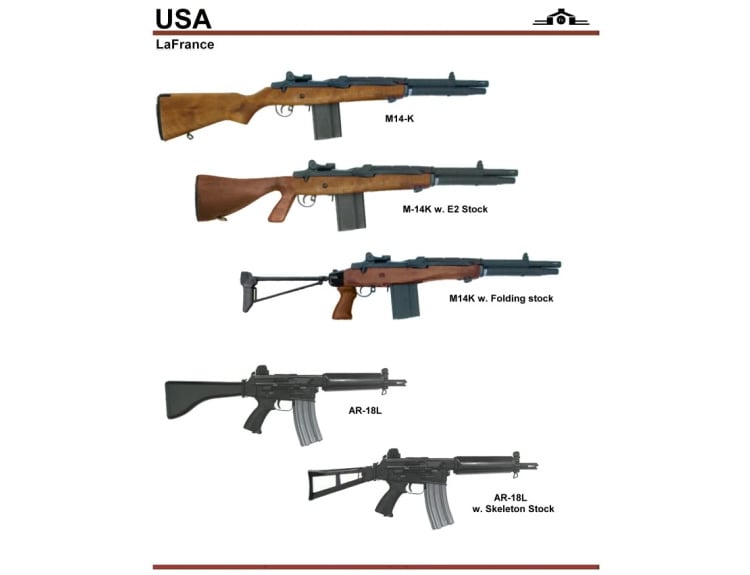



Configurations varied but the barrel could be as short as 13 inches. These were built on Smith Enterprises receivers and were sold, prior to 1986, as NFA-transferrable machine guns. Reportedly they saw some use in conflicts in Latin America. Transferrable ones are still for sale on the NFA market if you’ve got a lot of money burning a hole in your pocket.

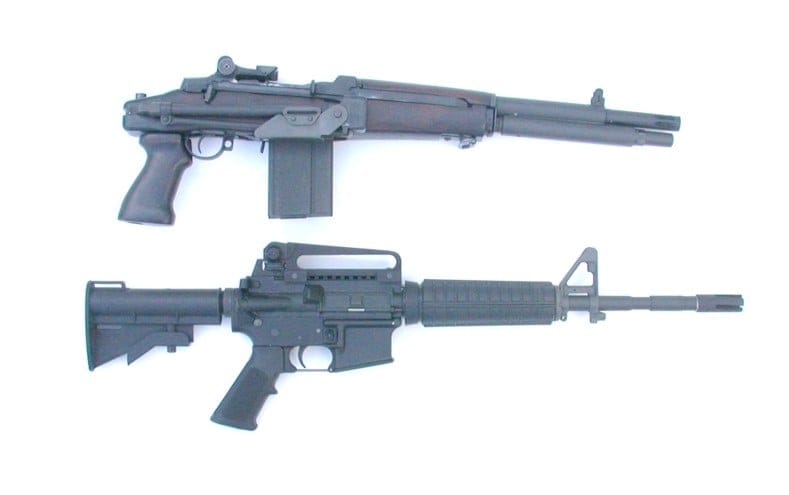
M1A Variants Over the Years
The first Springfield Armory M1A carbine version I am aware of was called the “Bush Rifle,” introduced in the early 1990s. It was an otherwise-stock M1A rifle made with an 18” barrel, making it more compact and lighter than the standard model with its 22” barrel. This was superseded in the late 1990s by the M1A Scout Squad Rifle of similar configuration, but with two notable differences: the flash hider has been replaced with a muzzle brake (making it legal for sale in California), and a Picatinny rail has been added to the upper handguard, allowing for the mounting of long-eye-relief optics (so-called Scout Scopes). This model, marketed heavily to law enforcement around the turn of the century, is still available from Springfield Armory.
Mr. Guns-n-Gear shoots the M1A Scout/Squad Rifle.
The “Scout Rifle” is a concept developed by the late LTC Jeff Cooper and is described in detail in his book, The Art of the Rifle. The long-eye-relief scope wasn’t the defining characteristic, and the Colonel himself once opined that the M1A Scout Squad was too heavy to truly be classified as a scout rifle. (As an aside, The Art of the Rifle remains an excellent resource on the fundamentals of rifle marksmanship. I highly recommend giving it a read.)
Not content with merely shortening the M1A rifle once, Springfield Armory conspired to shorten it even more and introduced the SOCOM-16 variant circa 2004. (The name is a marketing gimmick typical of the early days of the Global War on Terror. To my knowledge, this particular rifle was never used or endorsed by Special Operations Command.) This model retains the forward-mounted Picatinny rail of the Scout-Squad, but the barrel is abbreviated to only 16.25”. These rifles come equipped with a proprietary muzzle brake and different sights.

The sights on the SOCOM-16 versions are geared toward fast, close-range shooting. The rear sight is what used to be called a “ghost ring”. It has a large aperture for quick and easy sighting. The front sight is made by XS Sights and is much thicker than a standard M14 front sight post. It is a night sight and is equipped with a tritium lamp. Younger shooters may find all this emphasis on the sights to be puzzling, but back in 2004, metallic sights were still widely employed by both law enforcement and the military as primary aiming systems.
The SOCOM-16 was followed later by the SOCOM II, which was identical save for a bulky quad-rail setup around the forend. Keep in mind that this was before the invention of either KeyMod or M-LOK, so if you wanted to bolt stuff to your gun, you needed a Picatinny rail. Variants currently available include models with a pistol grip stock and M-LOK slots on the forend.

The M1A Tanker
A recent variation of the M1A is the “Tanker” model, the subject of this article. This is essentially a standard SOCOM-16 with two differences: it is equipped with a walnut stock and lacks the Picatinny rail mount on top of the barrel. Other than that, it appears identical to the SOCOM-16.
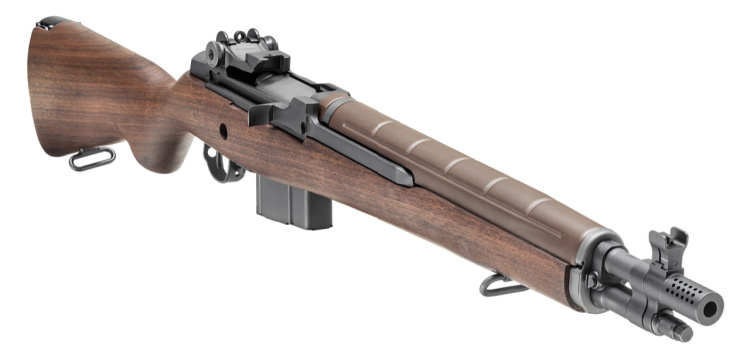
The Armory Life discusses the M1A Tanker
Why do they call it the Tanker model?
That’s a good question and answering it requires a little explanation. In 1944-45, the US military experimented with trying to make a shortened M1 Garand rifle. It was primarily envisioned as a more compact weapon for paratroopers. Several independent efforts were made and various prototypes were produced and tested, both in garrison and in combat. Ultimately, none were adopted and the project was abandoned.
After the war, several different firms and gunsmiths took to building M1 Garand rifles from surplus parts. Shortened carbine versions were developed, dubbed “Tanker” versions. The idea was, apparently, that during the war, a shortened M1 rifle would have been developed for or employed by armor troops, i.e., tankers. As far as I know, this was never actually the intent of the wartime efforts to shorten the Garand. Nonetheless, the “Tanker” moniker has hung in there for shortened M1 rifles ever since the 1960s. For an in-depth discussion of this topic, I recommend you read this excellent article from Bruce N. Canfield at the American Rifleman.
The Springfield Armory M1A is not an M1 Garand, but is definitely a derivative of it. With the short barrel and wooden stock, it certainly brings to mind those experimental shortened rifles from late in the Secon World War. This, I presume, is why they chose the name they did.
M1A Tanker Review
This article will serve as an overview of the rifle and my thoughts on it, not an in-depth review. The M1A rifle has been in production for nearly fifty years at this point, and the 16” carbine models are well into their second decade on the market. They have been reviewed, in-depth, time and time again, and a little research will supply you with plenty of reading and videos to watch. For my part, I have never owned any variant of the M14 rifle before (having decided back in 2001 to go with the FAL instead), and have only shot one a handful of times. I set to familiarizing myself with the layout and operation of the weapon.
The first thing you notice when picking up the M1A Tanker is its heft.
At just over nine pounds with an empty, 20-round magazine, it is not a lightweight rifle. It’s a relic of a bygone era when firearms were made from wood and steel, and despite being of recent manufacture, it feels like holding a piece of history.
The short barrel and stubby muzzle brake give the rifle a snub-nosed or sawed-off appearance, but reduce the overall length to about 37”. While the standard M14/M1A is beautiful and even the 18” models are visually appealing, the proportions of the Tanker/SOCOM-16 seem a little off. The rifle sort of stops where you expect there to be more. It looks, to paraphrase Hobbes, nasty, brutish, and short. (Hobbes the English philosopher, not Hobbes the stuffed tiger. Zoomers, ask your parents.) Aesthetics are open to interpretation, however, and take a back seat to functionality.
How does it function?
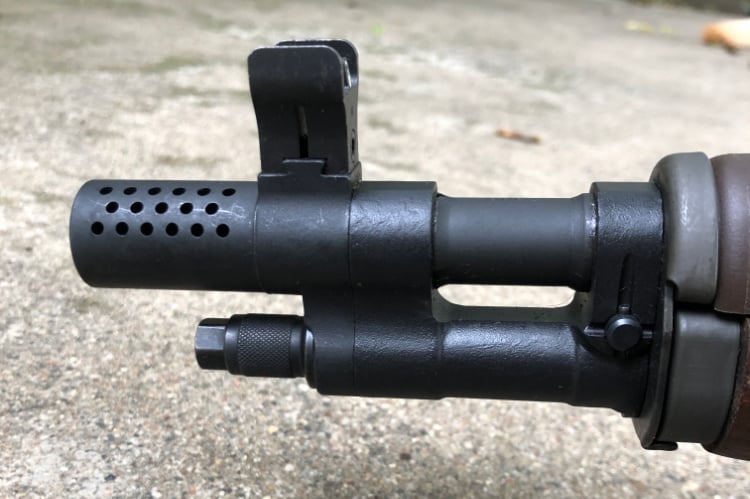
As I said, this type of rifle has been tested over and over again if you’re interested in the details of what It can and can’t do. I shot the rifle as it was sent to me, with only the steel sights and the two magazines it came with. I did not attempt to add any accessories or optics, save a basic nylon sling.
The overall fit and finish of the rifle are good.
I think it could be better on a rifle with an MSRP of over two thousand dollars, but there aren’t any blemishes or defects that I could find. The steel parts are parkerized and have a consistent, dark gray finish. The action is smooth, the sight adjustment knobs have audible and tactile clicks, and while the safety is stiff it’s very positive. Magazines insert and eject without difficulty, once you get the hang of the specific angle at which they have to be rocked and locked into position. The magazine release paddle could stand to be larger, in my opinion, but it is serviceable as-is.
The open-top receiver makes accessing the chamber area easier.
It can simplify identifying and clearing stoppages, as well as cleaning. This also means, however, that it’s easier for dirt and debris to get into the action.

The top handguard is brown plastic.
The stock is American walnut, nothing fancy, but solid and with an even, matte finish. It’s equipped with front and rear sling loops (which, I was pleased to note, do not rotate) and a steel buttplate.

The buttplate is like the one on the USGI M14.
The fit of this part isn’t as good as it ought to be, in my opinion. The buttplate is slightly narrower than the stock and leaves exposed a shelf of rough wood around it. I contacted Springfield Armory directly and sent them these pictures. I was told the following by a customer service representative:
“That is not abnormal. That is how the butt plate fits with the walnut stock. I did confirm this with my technician, and he did say they are all that way.”
I don’t have another M1A rifle to compare it to, but that was what the manufacturer told me. This issue is cosmetic and the buttplate is perfectly serviceable as-is. It features a textured, folding hinge cover (long theorized to be the infamous “shoulder thing that goes up”) which, when opened, reveals a hatch for a buttstock storage compartment. Traditionally, compact cleaning kits were kept in these, but you can put whatever you want in it. Fill it up with Skittles, I don’t care.

Magazines
According to Springfield’s website, the rifle is supposed to ship with two 10-round magazines, but mine came with two steel 20-round ones instead. They are unmarked and I do not know when or where they were produced. In searching for more I was dismayed to find that M14 magazines are harder to find and more expensive than they used to be. Military contract ones are not as abundant as they were ten or fifteen years ago. However, you can buy brand new magazines, manufactured by Springfield Armory, in 5-, 10-, and 20-round capacities and the surplus ones are still out there if you can find them.
You don’t even have to detach the magazine to reload the rifle if you don’t want to. The open-top receiver design allows for the insertion of single rounds directly into the magazine. It also comes equipped with a stripper clip guide. If you pre-load your ammunition onto 5-round stripper clips, you can insert them into the magazine, stripping the rounds from the clip, then remove and discard the clip itself. This method of reloading works but is not quick. It was an obsolescent feature even when the M14 was introduced. It’s a holdover from an earlier generation of military rifles, like the M1903 Springfield, which were primarily loaded this manner.
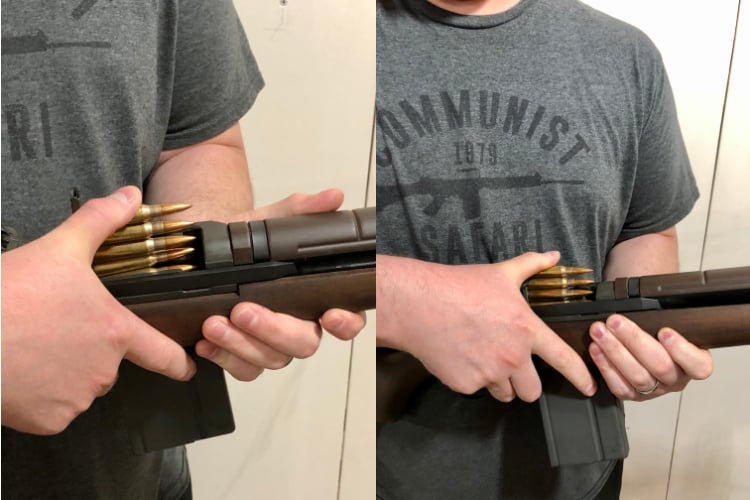
That said, if you’re concerned with an “end of the world as we know it” scenario, however unlikely, you may find this feature a point in the M1A’s favor. You can run it even if you only have the one magazine and lack any spares.
The trigger of the rifle is a nice, military two-stage type.
It breaks cleanly and has a positive, audible reset. It’s far and away superior to the stock trigger of a G3 rifle and is noticeably better than the FAL or the AK.

The safety is taken straight from the M1 Garand and is a metal tab that protrudes into the trigger guard.
When the safety is engaged, the tab is to the rear. To disengage it, push the tab forward with your trigger finger. This safety takes a little getting used to, and some are uncomfortable with having to put their fingers into the trigger guard to actuate it. With a little practice, though, it can be used safely and efficiently.

The rifle has a fixed charging handle on the right side, similar to a Kalashnikov.
The bolt locks to the rear when the magazine is empty. After replacing the magazine, you need only pull back on the bolt handle slightly and let it fly forward to load the rifle. There is a bolt catch on the left side of the receiver, just below the stripper clip guide, which allows you to manually lock the bolt to the rear without a magazine inserted. In stock configuration, this catch does not function as a bolt release.
The sights are fast on target and excellent for rapid engagement at short ranges.
The large sight aperture allows a lot of light through and the big, high-visibility front sight post provides for an easy-to-find aiming point, even with both eyes open. This sight setup will be less useful at longer ranges, however. The thick front sight will obscure much of the target beyond 150 to 200 yards.

As an aside, I, unfortunately, must point out that the tritium lamp in the XS front sight has almost burned out. It’s barely visible even in a completely darkened room and isn’t bright enough to be useful. Given that the M1A Tanker was only introduced recently and that the half-life of Tritium is 12.32 years, I think this rifle was assembled from old stock parts.

The rifle, as equipped, has no provision for mounting an optic, save a small hole in the left side of the receiver that serves as an attachment point for scope mounts. The M14/M1A can be scoped and has successfully been employed, in combat, with optics for decades. However, adding an optical sight will require the purchase and installation of a separate mount. There is a variety of these on the market from multiple manufacturers and I can’t offer any advice on which ones are preferable to others. Just realize that some of them can be quite expensive; Springfield Armory charges $155 for an aluminum scope mount and $299 for a steel one.
So how does the Tanker shoot?
The first magazine I ran through the rifle did not instill me with confidence. The rifle would not cycle at all from one of the supplied 20-round steel magazines, loaded with Rainier Arms ammunition. I could not get the rifle to fire twice in succession and was worried that something might be very wrong with it. I got several different kinds of malfunctions including double feeds, failures to feed, and stovepipes.

I switched to the other magazine, which was loaded with twenty rounds of Wolf-brand .308 ammunition, the kind with the lacquered steel case. The M1A Tanker ran through the entire magazine without any issue and locked back on empty. This told me that the issue was probably with the magazine, and not the rifle itself.
Upon closer inspection, I noticed that the offending magazine’s right-hand feed lip was bent slightly farther outward than those on the functional magazine. It was just enough extra clearance that rounds would pop loose from the magazine upon cycling and cause malfunctions. I was able to bend the feed lip inward just a bit, to where it matched the contour of the other magazine, and from then on it worked well. The magazine in question is unmarked and I’m not sure of its origin. It’s possible it’s a vintage, military surplus magazine that has seen some use and rough handling.
I tested three kinds of ammunition
- Rainier Arms FMJ, which mimics 7.62mm NATO Ball;
- Winchester 7.62x51mm M80 Ball,
- and the aforementioned Wolf 150-grain FMJ.
After the magazine issue was fixed I experienced no malfunctions of any kind, not even with the lacquered steel case ammunition.
According to my chronograph, the Rainier Arms ammo had an average velocity of 2657 feet per second. The Winchester averaged 2706 FPS, and the Wolf only 2389 FPS. By way of comparison, I shot the same ammo through a .308-caliber AR rifle with an 18” barrel. The average velocities for the Rainier, Winchester, and Wolf, from the longer barrel, were 2733, 2716, and 2496 feet per second, respectively. Velocity differences between the 16.25” and 18” barrels ranged from minor to insignificant. Wolf benefitted the most from the longer barrel but still gained less than 100 FPS. Wolf steel-cased .308, in my experience, is functional but offers significantly lower velocities than comparable ammunition from other manufacturers. A 150-grain bullet at only 2,389 feet per second is comparable to a .30-30.
The rifle’s recoil was pleasant.
Muzzle blast from the brake can be obnoxious if you’re standing next to the shooter, but from behind the weapon, there was no unpleasant concussion that I could detect. My wife was able to shoot the rifle from the standing position and thought it was fun, if a little heavy.
In all fairness, the M14 did have its share of problems.
Its troubled procurement process was one of the factors that led to the closure of the government’s Springfield Armory. The M14 rifle was intended to replace a variety of World War Two-era firearms, everything from the M1 Rifle, the M1918 BAR, the M1 Carbine, and the M3 “Grease Gun”. That’s a tall order for any design, much less one that is essentially a product-improved Garand. Regardless of any functional issues the M14 had, the entire program was set up to fail, and fail it did. The M14 has the distinction of having the shortest tenure of any primary US military rifle: it was adopted by the US Army in 1958 and was officially replaced by the M16 only a decade later.
Small Arms Solutions discusses why he “despises” the M14 Rifle
However, for all its faults, the M14 family soldiered on well into the 21st Century.
It was hauled out of storage and returned to service for the Global War on Terror, rebuilt and modernized for the battlefields of Iraq and Afghanistan. There were multiple configurations built by and for the Army, Navy, Air Force, and Marine Corps. Smith Enterprises provided many of the parts and knowledge for these projects and still manufactures excellent parts and accessories for the M14 family of rifles. Most had 22” barrels but others were rebuilt with shorter 18” barrels. Examples were the Mk14 Enhanced Battle Rifle, the Mk14 Mod 0, a the M21A5 Crazy Horse Rifle.

Such M14s were on the front lines even in 2011 when I deployed to Afghanistan, and have only recently been retired. That’s not bad for a rifle that was, essentially, designed in the 1930s. Despite its obsolescent design, the M1A can still get the job done. Chris Hernandez discusses its modern usage here.
All in all, I’m pleased with the M1A Tanker and intend to keep it.
It wouldn’t be my first choice for a .308 battle rifle; the open receiver complicates optics mounting and the M1A family has gotten to be quite expensive. That said, if it was all that was available to me I would be fine with it. If I lived in California or some such firearms-restricting dystopia, I’d much prefer an M1A with detachable, 10-round magazines over a bastardized .308 AR that needs a bullet button or can’t have a proper grip. There aren’t a lot of problems that can be solved with a .308 rifle but cannot be solved with one limited to 10+1 capacity.
So, whether you’re trapped in politically hostile territory or just prefer the old school of guns, the M1A is a proven design that has been around long enough to get the bugs worked out. Its heyday has definitely passed and parts and accessories aren’t as abundant as they were before, but there is still plenty of aftermarket support for the type.
The M14 was derived from the M1 Garand. An article for The American Rifleman, entitled The M14: John Garand’s Final Legacy talks about the evolution of the design, from M1 to M14, in detail, and is worth a read if you’re interested in the matter. This meant that the M14 was, in many ways, a dated design even when it was originally fielded.
Its main contemporaries, the H&K G3 and the FN FAL, saw much wider service, were developed into more numerous variations, were much more widely produced, and served for decades after the M14 was officially retired. The only foreign countries to issue the M14 were ones who received them from the United States.
It’s popular in some corners of the Internet Gun Culture hate on and bash the M14. Some insist that it’s overrated nostalgia-bait only loved by “Boomer-Fudds”, and you’ll find young shooters who have never touched an M14 going on about how terrible it is. Some have gone so far as to stay it’s the worst rifle the US military ever fielded.
In conclusion, the M14 in any variation isn’t the latest or greatest.
It’s an old design with a long history and its own share of pros and cons. In spite of its shortcomings, it’s proven itself capable of taking on a wide variety of missions all over the world, from the ranges of Camp Perry to the mountains of Afghanistan. Variants are presently available from Springfield Armory, Bula Defense, and Fulton Armory. You’ll spend more on one than you will on an AR-15 of equivalent quality, but if you want old-school American steel, an M14 can serve you well.



